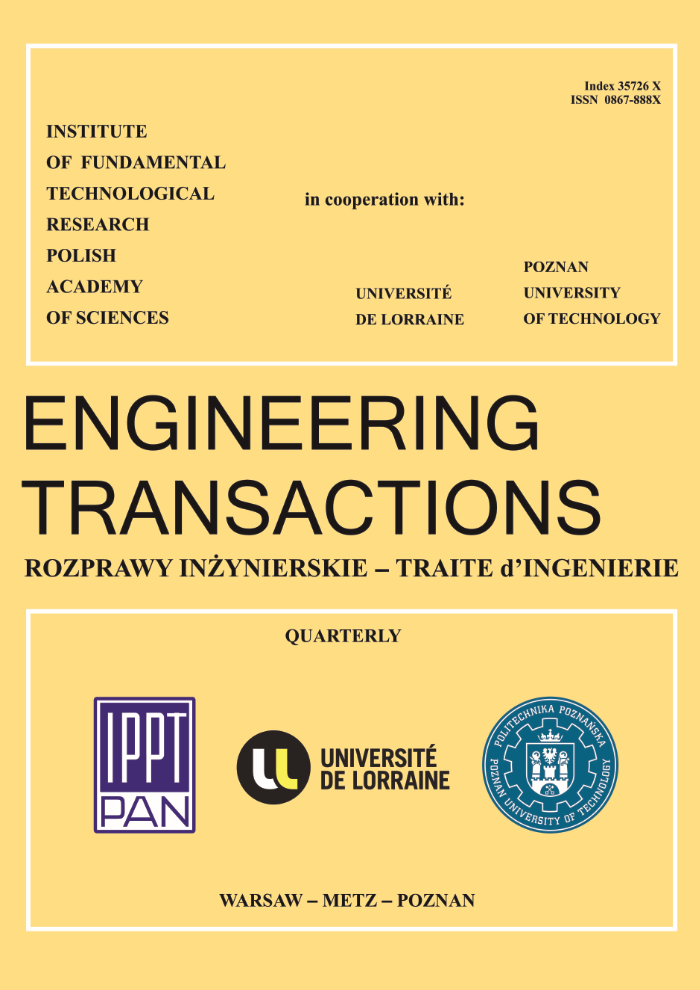Abstract
The multiobjective optimization of a two-scale thermoelastic problem is considered in this paper. To compute the solutions, direct thermoelastic analysis with the representative volume element (RVE) and the finite element method (FEM) analysis are performed. Evolutionary algorithms (EAs) are used to find a set of Pareto-optimal solutions. The design variables of the optimization problem are defined so as to describe the microstructure of a porous solid, whereas the optimization criteria are defined on the basis of macro-scale thermal and mechanical quantities. A numerical example of optimization is included.Keywords:
evolutionary algorithms, multiobjective optimization, multiscale modelling, porous solid, thermoelasticityReferences
[1] Abraham A., Jain L., Goldberg R., Evolutionary multiobjective optimization: Theoretical advances and applications, Springer-Verlag London Limited, 2005.
[2] Andersson J., A survey of multiobjective optimization in engineering design, Technical Report: LiTH-IKP-R-1097, 2000.
[3] Carter J., Booker J., Finite element analysis of coupled thermoelasticity, Computer and Structures, 31(1): 73–80, 1989.
[4] Długosz A., Burczyński T., Multiobjective shape optimization of selected coupled problems by means of evolutionary algorithms, Bulletin of the Polish Academy of Sciences, Technical Sciences, 60(2): 215–222, 2012.
[5] Długosz A., Burczyński T., Identification in multiscale thermoelastic problems, Computer Assisted Mechanics and Engineering Sciences, 20(4): 325–336, 2013.
[6] Deb K., Pratap A., Agarwal S., Meyarivan T., A fast and elitist multi-objective genetic algorithm: NSGA-II, IEEE Transaction on Evolutionary Computation, 6(2): 181–197, 2002.
[7] Fish J., Bridging the scales in nano engineering and science, Journal of Nanoparticle Research, 8(5): 577–594, 2006.
[8] Michalewicz, Z., Genetic algorithms + data structures = evolutionary algorithms, Springer-Verlag, Berlin, 1996.
[9] Terada K., Kurumatani M., Ushida T., Kikuchi N., A method of two-scale thermomechanical analysis for porous solids with micro-scale heat transfer, Computational Mechanics, 46(2): 269–285, 2010.
[10] Zienkiewicz O.C., Taylor R.L., The Finite Element Method, 5th ed., Butterworth-Heinemann, Oxford, 2000.
[11] Zohdi T., Wriggers P., An introduction to computational micromechanics, 2nd ed., Springer-Verlag, Berlin – Heidelberg, 2008.
[2] Andersson J., A survey of multiobjective optimization in engineering design, Technical Report: LiTH-IKP-R-1097, 2000.
[3] Carter J., Booker J., Finite element analysis of coupled thermoelasticity, Computer and Structures, 31(1): 73–80, 1989.
[4] Długosz A., Burczyński T., Multiobjective shape optimization of selected coupled problems by means of evolutionary algorithms, Bulletin of the Polish Academy of Sciences, Technical Sciences, 60(2): 215–222, 2012.
[5] Długosz A., Burczyński T., Identification in multiscale thermoelastic problems, Computer Assisted Mechanics and Engineering Sciences, 20(4): 325–336, 2013.
[6] Deb K., Pratap A., Agarwal S., Meyarivan T., A fast and elitist multi-objective genetic algorithm: NSGA-II, IEEE Transaction on Evolutionary Computation, 6(2): 181–197, 2002.
[7] Fish J., Bridging the scales in nano engineering and science, Journal of Nanoparticle Research, 8(5): 577–594, 2006.
[8] Michalewicz, Z., Genetic algorithms + data structures = evolutionary algorithms, Springer-Verlag, Berlin, 1996.
[9] Terada K., Kurumatani M., Ushida T., Kikuchi N., A method of two-scale thermomechanical analysis for porous solids with micro-scale heat transfer, Computational Mechanics, 46(2): 269–285, 2010.
[10] Zienkiewicz O.C., Taylor R.L., The Finite Element Method, 5th ed., Butterworth-Heinemann, Oxford, 2000.
[11] Zohdi T., Wriggers P., An introduction to computational micromechanics, 2nd ed., Springer-Verlag, Berlin – Heidelberg, 2008.






